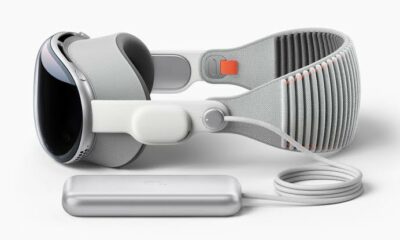Tech News
Rolls-Royce Phantom (2017) review
The Rolls-Royce Phantom is the car industry’s longest-running nameplate. The first one, launched 92 years ago, replaced the Silver Ghost, renowned rightly as ‘the best car in the world’.
Since then, Phantoms of various flavour but invariably prodigious proportions have ranged from technologically state-of-the-art cars, to stately carriages that have been about as cutting-edge as a grandfather clock, though always nicely crafted. From the ‘60s to the ‘90s, especially, Phantoms were more royal curios than contemporary cars, about as modern as the monarchy – although John Lennon’s Phantom V at least had a fun paint scheme.
The latest Phantom, the VIII – the use of quaint Roman numerals underlines the long-running heritage – looks very much like the (excellent) old VII, at least at first glance. In fact it’s sleeker – note the faired-in grille, and more raked rear screen – and all the mechanicals are new, too, from fresh ‘Architecture of Luxury’ aluminium platform that will underpin all upcoming Rolls-Royces, to a new V12, twin turbocharged to boost waftability.

Naturally, the overarching goal is to make the world’s pre-eminent luxury car – the most cosseting, most comfortable, most stately, most individualistic, most beautifully appointed, most extravagant and most expensive. As we shall soon see, it sits atop the luxury saloon sector with majestic ease, and almost disdainful superiority.
Similar style, new technology
Design director Giles Taylor sees the Phantom’s design as classical as the 911’s – so no need (or wish) for revolution here; like their royal patrons, Rolls-Roycehates revolution. It’s very much an evolution of the previous Phantom’s shape, and Taylor will cheerfully point to the high bluff nose, rounded balloon front wings, long bonnet, flowing flanks, elongated wheelbase and short tail as 92-year-and-counting styling continuums.
The new one is now smoother and slightly softer in overall shape, the grille is mildly raked back (and flush with the surrounding bodywork) and the whole character is a bit less formal and upright, more laid back. After all, buyers are now just as likely to be rappers as royals.

Length is a touch shorter than the outgoing car’s, but only by 80mm or so. Yet at 5.76 metres (normal wheelbase) and 5.98 metres (extended wheelbase) the Phantom remains, by some margin, the world’s longest production car. Rolls-Royce could not stretch the extended wheelbase version beyond six metres, for the very good reason that in China – its number two global market – you now need a bus driver’s licence to steer anything longer. Unsurprisingly, that would not have gone down well with your typical thrusting Shanghai tech zillionaire. Wheelbase is slightly up on the old Phantom’s to increase rear legroom. Weight is unchanged, at a vast 2.56 tonnes. Plenty of XL SUVs are lighter.
That new family aluminium architecture – next year it underpins the new Rolls-Royce SUV – is lighter and 30 per cent stiffer than the old Phantom’s spaceframe chassis. The extra stiffness boosts ride comfort and refinement, to which larger (twice the volume) air springs and new softer-walled tyres also play noble supporting roles. Active anti-roll bars, which disengage when not needed, further boost ride suppleness. Ride comfort is fantastic, a cut above anything on the road.
The other big technical upgrade is the new 6.75-litre motor, based on the Ghost’s V12 but extensively fettled. Unlike the old naturally aspirated Phantom, the new V12 uses turbochargers to boost low-end torque, and make performance even more effortless.
The engine punches with silken smoothness – it’s never jerky – and response is instant. It’s also incredibly quiet, as eerily silent as an electric motor. Only when accelerating hard does some faint induction slurp betray its internal combustion.

On the move, this is probably the quietest car that’s ever laid tyre to tarmac. It’s a leather-lined library in the fast lane, as silent as a cathedral and as imposing as one, too. The loudest noise is no longer the ticking of the clock, as famously claimed on older Rolls-Royces as the clock is now electric. Rather, it’s the shuffling of your hands on the (thicker) leather steering rim. The silence is so complete that some engineers were concerned it may be too quiet. It almost feels unnatural.
It’s not just the silken V12 that’s responsible. There’s a whopping 130kg of sound deadening to silence any pesky groans or whines, and the tyres are foam filled and sealed to mute any tyre cavity thrum.
Great in the back seat, surprisingly good up front too
The cabin is wonderful. The finest leathers (from beefy Bavarian bulls), lovely wood veneers from Africa, South America, Italy, China and California, and made-in-England lamb’s wool carpets. Rear wood marquetry picnic tables pop down, just as high-res screens pop up, tech meets trad. A drinks cabinet is neatly packaged in the leather and wood lined central armrest, with coolbox and twin champagne flutes (although, disappointingly on our test car, the bubbly on offer was sparkling water). The headrests are pillow-soft, the rear seats – individual or loungechair, you choose – are expansive and cossetting.

Entry and exit are by vast rear-hinged doors, all the better for the rear-seat ‘patron’ – as Rolls-Royce quaintly refers to its customers – to make an impact on arrival. Naturally, the big rear pillar neatly hides the patron’s face, until he or she leans forward to reveal his or her visage to the curious world.
Every Phantom will be customised to some extent – there is really no such thing as a ‘standard’ specification. There are so many splendid details, such as the starlight headliner – its LEDs can twinkle, or concentrate light for map reading. Perhaps the most novel new sign of bespokery is the ‘gallery’. This replaces much of the dashboard with a glass-covered display area, behind which the ‘patron’ can commission his or her own artwork. It could be made from silk, metal work, porcelain or be an oil painting. Or whatever else patron desires.

And to drive? For such a vast and heavy car, it’s surprisingly good. The steering is light but precise – you can punt this car down a winding road with amazing elan, relishing the on-demand torque (I even found myself missing paddle shifters). Maybe lateral seat support could be better – but not let’s pretend it’s a sports saloon. Rather, the Flying Lady can lift her skirts, and run hard, when you want her to.
Verdict
Best luxury saloon car in the world? Yes, and by some margin.
The Bentley Mulsanne and top-end Maybach version of the Mercedes S-class don’t even come close to the Phantom’s astonishingly blend of comfort, opulence, craftsmanship and sheer presence.
Mind you, at £360,000, the Phantom’s price is way north of anything Bentley or Mercedes can offer. Few people will ‘only’ spend £360K on their Phantom, either. All will customise to some extent, easily inflating the price to well over £400,000. Many will spend more than a million pounds, says Anglophile CEO Torsten Müller-Ötvös.

source: http://www.carmagazine.co.uk/car-reviews/rolls-royce/rolls-royce-phantom-2017-review/
You may like
-


Apple fans are starting to return their Vision Pros / Comfort, headache, and eye strain are among the top reasons people say they’re returning their Vision Pro headsets.
-
Google’s AI Chatbot Gemini Raises Privacy Concerns with Data Retention Strategy
-


OpenAI CEO wants to raise not billions, but trillions, here’s why

